Learning theories

Five Current Learning Theories
Learning theories unpack complex cognitive processes and provide useful mental models for educators to structure and design courses around, while also providing insights on best practices during and after learning experiences. However, even for the most experienced educator, navigating through the theoretical foundations of how students learn and the multitude of learning methodologies out there can be a daunting experience. The following summary of the social learning theory diagram cuts through some of the complexity to get to focus on the essential components of different major learning theories in education, and how this might translate to the classroom or corporate workplace.
1 . Behaviorism
First on our education theories list is behaviorism. Behaviorism in education definition is a pedagogical theory that defines learning as a process of knowledge acquisition that takes place through observation (i.e., based on objectively quantifiable events rather than introspective psychology).
No doubt, you have probably heard of Pavlov’s dog before. Pavlovian conditioning, named after the Russian physiologist Ivan Pavlov, is when a particular stimulus is used to elicit a predictable response. Pavlov discovered that he could trigger salivation in dogs through the use of a bell, after associating that bell with food. Educational theorists such as B.F. Skinner revised Pavlov’s theory of ‘learning by association’ by putting forward a theory of operant conditioning, that demonstrated that behaviors of learners could be influenced by positive or negative reinforcements.
How, then, does behaviorism translate to the classroom or corporate training environments? Behaviorism confirms that learning is strengthened through repeated action, and therefore, having a systematic routine where knowledge is revisited repeatedly, will undoubtedly reinforce learning.
Feedback is also an important component of behaviorism, especially when it is used as a form of positive reinforcement. In order to strengthen positive associations with learning, the timing of the feedback matters. Behaviorists would argue that for feedback to be an effective form of association, it should be immediate—something that becomes much more achievable in the microlearning context when students receive instant rewards for correctly completing tasks or frequently logging in. It is, however, important to note that the behaviorist school of thought is almost entirely dependent on teacher/instructor input and views the learner as a passive recipient of information.
2. Cognitivism
Cognitivism, as suggested by the name, is one of the educational theories and the learning theory that focus on cognitive processes of the mind such as thinking, memory, recall, and problem-solving. Similar to behaviorism, cognitivism is about learning via association; however, the emphasis is placed on internal processing rather than the external environment.

In contrast to behaviorism, associations are based on creating links between new understandings and prior knowledge. Cognitivism also differs from behaviorism by acknowledging that learners process and encode information in different ways. Social Cognitive Theory (SCT) is a major stand of cognitivism that asserts that observing others, especially one’s peers, is the most effective form of knowledge acquisition. So how do we translate cognitivism in the classroom? Collaborative problem-solving, discussion-based activities, and peer-to-peer teaching are ideal activity formats that enable social interactions that enhance learning. To support the creation of mental associations, it is important that information is chunked into groups, and discrete segments of knowledge are linked together. In order to further knowledge associations, be sure to tie theory back to real-world examples. Other methods of association might include using mnemonics, analogies, or visual cues.
3. Constructivism
Constructivism is a student-centered learning theory that is based on cumulatively building understandings from students’ prior experiences and knowledge. In other words, to continue the construction analogy, learning becomes a process of constructing new knowledge on the foundation of what is already known. Essentially, it places learning in a familiar context and aims to translate abstract theories into relatable concepts.
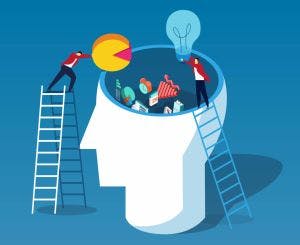
Done well, constructivist-based learning is always relevant. Any stand-alone theory should be reframed to have links to practice or real-world scenarios. Whether knowingly or unknowingly, most classroom teachers and learning theorists will be taking a constructivist approach to every lesson when they use engagement hooks that relate back to the world of the student and provide an ‘association anchor’ for new information about the be introduced. Knowing your students or learner audience is absolutely essential when practicing constructivism as an educator. For this reason, pre-assessments, surveys, interviews and learning journals are all useful tools to be used before and during any learning experience.
Constructivism provides an alternative to teacher-directed curriculum design by essentially allowing student experiences to dictate the direction of learning. Because constructivist-oriented learning revolves around the understandings and experiences of the students, it is inherently a dynamic and ever-changing process.
4. Humanism
Humanism approaches learning and education with a growth mindset. Similar to constructivism, humanism is a school of educational thought that is inherently student-centered. Humanistic education derives many of its values from the intellectual movement of the seventeenth century, where philosophes such as Voltaire (1642-1778) believed that humans were born with innate potential.
Humanistic education, therefore, focuses on fostering individual potential and personal growth. Humanism tends to be even more individual-focused than constructivism, with an emphasis placed on choice and autonomy. Educators adopting a humanist approach aim to foster self-directed learning among students, in the belief intrinsic motivation to learn comes from this. In order to support self-directed learning, teaching students how to learn becomes a key priority. Along the same lines, humanist educators believe that learners should be given opportunities to evaluate their own learning, whether that be through formalized self-assessment or descriptive, reflective journaling.
It is important to note that unlike most other schools of thought in this educational theories list, humanism gives equal weight to the cognitive (knowledge) and affective (feeling) domains, which not only impact what and how content is conveyed, but also how outcomes are measured. A humanistic education aims to redefine what traditional academic success looks like. When it comes to measuring student outcomes, humanistic educators take a more holistic view in that they view emotions, moral understandings, and knowledge as equally important outcomes in a learning experience, and therefore, tend to avoid traditional grading.
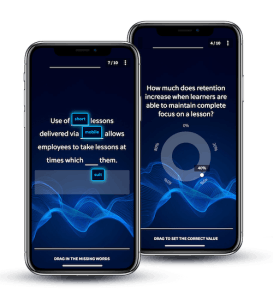
5. Connectivism
Connectivism is inherently a future-focused learning theory and education of theory. It is a relatively recent pedagogical view that takes into account the changing nature of knowledge acquisition in our digital age. In contrast to constructivism, which revolves around what a learner already knows, connectivism pinpoints what a learner needs to know, and targets the learning at a relevant time of need.
While connectivists generally believe that expanding knowledge is ultimately more important than taking into account prior knowledge, connectivism allows learners to situate new knowledge within existing schemas of understanding. Similar to humanism, connectivism empowers students to make their own learning decisions. Students are aided in this learning process by technology, which assists in threading together different strands of knowledge.
Connectivism mirrors our ever-changing digital landscape in that it is forever changing and never static. According to Siemens (2004), a core principle of connectivism is that ‘learning and knowledge rest in diversity of opinions.’ Connectivist educators aim for precision in breaking up content into discrete segments in the form of short strategic bursts of learning, very much in line with the science of microlearning. Reflective of continuous learning cultures in corporate environments, connectivism recognizes that learning is a continual lifelong pursuit.
Discover the EdApp LMS & Authoring Tool built upon several modern learning theories
Learning Theorists — A Chronology
Within the broad schools of pedagogical thought, individual theorists provide more nuanced interpretations of educational psychology, along with valuable frameworks that can be directly applied within classrooms, online learning environments, or within corporate training. Teaching theories of teaching and learning by discussing education theorists is a great way to achieve a holistic perspective on learning.
To help you with learning theories in education, we've listed some famous educational theorists and their theories that helped form instructional theories essential to all kinds of modern training and teaching theories in education.
1. Piaget
Biologist and philosopher Jean Piaget’s contributions to developmental psychology and theories in education significantly impacted the way we understand knowledge acquisition. Piaget is famous for his developmental learning theory that outlines four stages of cognitive development (sensorimotor, preoperational, concrete operational, formal operational). We reach the ‘formal operations’ stage by adolescence. Although such research tended to focus on cognitive development in children, Piaget’s findings are equally applicable to adult education. According to Piaget, knowledge formation is a continual process of self-construction. As a cognitive constructivist, he theorized that learners process information by assimilating new knowledge into existing schemas.
In the process of assimilating new knowledge, existing structures of understanding are re-arranged. Because knowledge acquisition is a process of connecting new information to pre-existing knowledge, it is beneficial to link learning to the real world. Additionally, Piaget found that memories need to be continually revisited in order to establish long-term recall. We also know that confronting discrepant ideas within existing schemas is vital for learning growth. ‘To understand is to discover, or reconstruct by rediscovery,’ Piaget stated, ‘and such conditions must be complied with if in the future individuals are to be formed who are capable of production and creativity and not simply repetition’(Piaget, 1972, p.20).
2. Vygotsky
The Russian psychologist Lev Vygotsky further expanded Piaget’s constructivist foundation by focusing on how social interactions support learning. Vygotsky can be attributed with creating a new pedagogic strand that we refer to as ‘social constructivism.’ Vygotsky’s social constructivist theory defines learning as not just a process of constructing new knowledge on a foundation of pre-existing understandings, but as a process that takes place through social interactions. In order to maximize knowledge acquisition, educators should pitch content according to learners ‘Zone of Proximal Development.
’ The Zone of Proximal Development, or ZPD, targets learning that is challenging enough to require additional support from an educator or more experienced colleagues. In other words, you want to push learners out of their comfort zone, but not so far that they reach the ‘panic zone’ that is truly out of reach. In the words of Vygotsky, the ZPD is the ‘distance between the actual developmental level as determined by independent problem solving and the level of potential development as determined through problem-solving under adult guidance or in collaboration with more capable peers’ (Vygotsky, 1978, p. 86). Therefore, when designing any curriculum, whether digital or face-to-face, support should be embedded into the process. It is only by providing this support that independent learning can be fostered.
Figure 1: The Vygotskian Zone of Proximal Development
Source: Wikimedia Commons
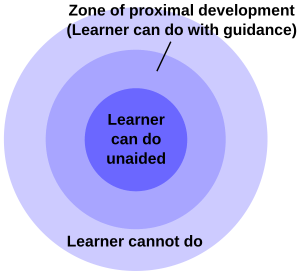
3. Bloom
American psychologist Benjamin Bloom complemented theories in education when proposing a taxonomy that ranked different modes of learning according to thinking skills. Although proposed in 1956, Bloom’s Taxonomy is still widely used in classrooms today and has undergone a number of revisions. The taxonomy is represented as a hierarchy of skills arranged from lower to highest order cognitive skills.
Within the three cognitive, psychomotor, and affective learning domains, learning goals are ranked in order of complexity from comprehension to evaluation. Whether designing a course for corporate training or mapping out a curriculum for use in the classroom, it is important to consider a balance between lower and higher-order outcomes derived from the taxonomy. Scaffolding tasks tend to draw on lower-order skills in the pyramid and require learners to recall knowledge without application.
In contrast, higher-order activities require application through evaluation and/or problem-solving and require a learner to draw on a broader base of prior knowledge. The revised version of Bloom’s Taxonomy (2001) more suitably addresses new standards in our knowledge economy, with a focus on creative thinking and transformation. The taxonomy is a powerful tool in either academic education or the corporate training environment, as it encourages active participatory learning and the formation of deep understandings.
Figure 2: The Revised Bloom’s Taxonomy
Source: https://www.flickr.com/photos/vandycft/29428436431
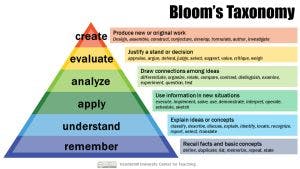
4. Gagné
Educational psychologist Robert Gagné expanded traditional definitions of learning outcomes and instructional theories. In 1985, Gagné expanded upon Blooms’s three learning domains to include: intellectual skills, cognitive strategy, verbal information, motor skills, and attitude. Gagné proposed that learning outcomes should be broken into these five different categories, which are further broken up into different elements (e.g., cognitive strategies refer to internal processes and metacognition).

Instructional Design Principles
Within the intellectual domain, Gagné provides a taxonomy of lower to higher-order cognitive skills, similar to Bloom, but pitched towards the instructional design field. Intellectual skills include:
- Discrimination
- Concrete concept
- Rule using
- Problem-solving
While such models are particularly useful when mapping out learning outcomes, Gagné later elaborated on the framework in his ‘Nine Events of Instruction’ (1992). Designed with adult learning in mind, this instructional design model can be a relevant tool in both corporate settings (digital or face-to-face) and the academic classroom to demonstrate an understanding of relevant theories.
The ‘Nine Events of Instruction’ outlines the ideal conditions for instruction:
- Gaining the learner’s attention.
- Informing the learner of the objectives.
- Stimulating recall of prior learning.
- Presenting the learning stimulus.
- Providing learning guidance.
- Eliciting appropriate performance.
- Providing feedback.
- Assessing learner performance.
- Enhancing retention and transfer.
The practical step-by-step model is designed to be implemented sequentially, as each step is part of a larger cumulative process. The model provides educators with a checklist to break down and organize course content. It assists learning designers to ensure that learning materials and tasks strategically contribute towards a specified learning outcome, and are presented in a manner that enhances retention.
5. Bruner
Like Vygotsky, Jerome Bruner, a cognitive psychologist and one of the key teaching and learning theorists, emphasized the inherently social nature of learning. Bruner theory sits within the social constructivist school of thought that emerged in the mid-1970s. Bruner expanded on Vygotsky’s theories by outlining how instructional support can maintain learning within a ‘Zone of Proximal Development’ (ZDP).
Unlike Vygotsky, however, Bruner maintained that knowledge acquisition could take place independently with the correct support structures in place. While students may initially rely on a high degree of support to reach their ZDP, Bruner proposes that these support structures are gradually removed over time (similar to temporary construction scaffolding), in order to foster greater independence in learners. As the scaffolding is dismantled, learning becomes a process of independent discovery. While Bruner first developed his scaffolding theory in relation to language formation in young children, it is equally relevant in academic or adult corporate learning. Bruner puts forward that the support structures should adapt to learner performance. That is, less support is needed as a learner demonstrates independent progress. In an eLearning environment, gauging learning progress via inbuilt metrics is an ideal way of knowing when to scale back or increase scaffolding.
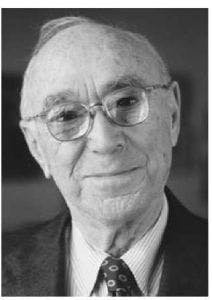
6. Gardner
The Harvard educational psychologist Howard Gardner once said that ‘Anything that is worth teaching can be presented in many different ways…[and that] these multiple ways can make use of our multiple intelligences.’ Gardner challenged traditional definitions of intelligence and revolutionized the way educators thought about individualizing learning. Back in 1967, Gardner co-founded Harvard University’s ‘Project Zero,’ which remains at the forefront of educational research today, with an overarching mission to make ‘thinking visible.’
Gardner’s ‘Frames of Mind’ model on multiple intelligences was published in 1983 and is still widely referred to by educators; walk into any primary school classroom, and you’ll likely see some version of Gardner’s multiple intelligences on brightly colored posters on the wall. Gardner identified seven different intelligences within the model: linguistic, logical-mathematical, spatial, musical, bodily-kinesthetic, interpersonal and intrapersonal. Rather than pigeon-holing learners into single categories, Gardner maintained that every learner had a unique blend of intelligences. Gardner’s learner-centered theory provides a more nuanced understanding of different learning styles. In order to embrace the spectrum of different intelligences across a cohort of learners, it is important that educators provide adaptable multimodal learning experiences.
Mobile microlearning provides an ideal platform to deliver a variety of experiences that cater to different intelligences. EdApp’s microlearning platform boasts over 80 templates to select from, ready to be tailored, resulting in a bespoke learning experience to suit every type of intelligence. Interactive drag-and-drop activities will particularly appeal to kinesthetic learners, while the use of infographics and diagrams will be most useful for spatial learners.
Figure 3: The Multiple Intelligence Spectrum
Source: Wikimedia Commons

7. Erikson
The post-Freudian psychologist Erik Erikson is most renowned for his research on psychosocial development which impacted learning theorists way after him. In particular, Erikson demonstrated the potential impact of social experiences across a lifetime, and their power to shape our identity. In this sense, social learning theory emphasizes that nurture rather than nature truly shapes who we are. Among other socio-cultural interactions, education plays a vital role in nurturing and supporting maturation. In the 1950s, Erikson outlined eight maturation stages from birth to death, not only focusing on cognitive potential, but also ego identity formation, emotional development, value development, and the impact of social environments.
According to Erikson, each of the stages is accompanied by opposing emotional forces (or ‘contrary dispositions’) that ideally need to be balanced in order to reach a state of equilibrium. Because Erikson defined the stages as cumulative, cognitive dissonance resolution inevitably impacts the progression to subsequent stages. How does this relate to the way we learn? Although the different stages represent neuroplastic windows of opportunity, and learning may become more challenging in later stages, re-development is possible (i.e., it is possible to backtrack through the stages). Although Erikson’s developmental learning theory is more commonly associated with the work of early childhood education theorists, his theory on the transformative power of social learning extends well beyond preschoolers and presents a compelling case for lifelong learning.
8. Kolb
Psychologist David Kolb made significant contributions towards brain-based learning theories, further expanding our understanding of different learning styles and how they fit into the learning cycle. In contrast to the VARK model, Kolb’s model focuses on internal cognitive processing. First outlining his theory in 1984, Kolb outlined two dimensions of learning that represent the two hemispheres of the brain: perception and processing. Perceived information is experienced by a learner on a continuum from concrete experiences to abstract conceptualizations. In the processing dimension, a learner might process information in the form of active experimentation or reflective observation.
Kolb contextualizes these learning styles as a part of an experimental process that moves from concrete or ‘hands-on’ experiences to abstract understandings and application through testing. Importantly, Kolb noted that individuals will have different preferences and abilities within the dimensions, leading to his subsequent development of a ‘learning style inventory.’ Convergers are particularly skilled in the practical application of concepts, in contrast to diverges who tend to be more skilled in creative thinking and mapping out conceptual details. Assimilators are particularly well known for transforming different concepts into theoretical models, but may not be so adept at putting theories into practice. Accommodators, however, are experts when it comes to translating theory into practice.
Figure 4: The Kolb Learning Cycle
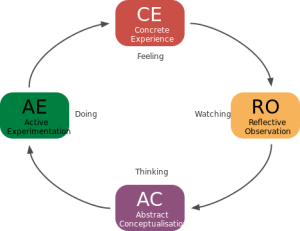
Source: Wikimedia Commons
9. Laird
Education consultant Dugan Laird pioneered what we understand to be sensory stimulation theory. Learning, according to Laird, occurs when the five senses of sight, hearing, touch, smell and taste are activated. ‘For people to change, they must invest their senses in the process,’ asserted Laird. Particularly relevant is the fact that three-quarters of adult learning is through seeing. Certainly, Laird’s theory provides a strong rationale for incorporating visual mediums such as video, animations and infographics into any learning experience.
The benefits of using visual teaching aids are further enhanced when combined with a variety of media intended to activate numerous senses. On the other hand, Laird’s research cautions against training in the form of long-form lectures or passive listening tasks, as only 13 percent of understandings are gained through hearing. The use of microlearning to deliver multimodal bite-sized chunks of content to learners certainly aligns with Laird’s research findings. In addition to Laird’s contributions to sensory stimulation theory, he has produced much work on andragogy (the study of adult learning).Laird sets out best practice principles of adult learning, also drawing on other relevant theories such as Kolb’s learning style inventory and applying them to a positive learning environment.
10. Skinner
Harvard psychologist B.F. Skinner’s theory on operant conditioning is one of many behavioral learning theories. In its simplest form, operant conditioning is a method of providing learners with behaviour prompts and rewarding desired actions. Skinner educational theory uses feedback as a method of positive and negative reinforcement. It might seem like a far leap to jump from conditioned lab rats pushing levers for food to microlearning, but hang in there.
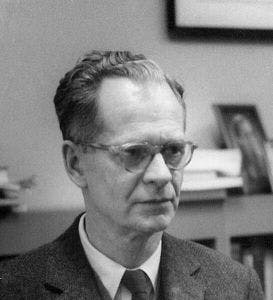
Unknowingly, Skinner’s work in the mid-1960s on technology-assisted learning, which he described as ‘programmed learning,’ was perhaps an early precursor to what we understand today as microlearning. Skinner’s ‘programmed learning’ involved chunking down segments of content with embedded feedback, establishing clearly defined learning objectives, cutting back on irrelevant stimuli in order to reduce cognitive load, and allowing learners to process and sequentially build knowledge within a ‘hierarchy of content’ (Skinner 1965).
Importantly, the difference between face-to-face classrooms and Skinner’s experimental ‘programmed learning’ was the ability for students to learn at their own pace and receive instant feedback. In particular, Skinner found that using technology to deliver instant feedback to learners had a significant impact on reinforcing desirable learning behaviors. In essence, the timing of feedback matters.
11. Rogers
Carl Rogers, the ‘Father of Humanistic Psychology,’ influenced pedagogical theories through his person-centered approach. Rogers as a theorist in education was able to transfer his learnings from client-centered therapy to challenge traditional pedagogical roles in the classroom. In his book, Freedom to Learn, first publishing in 1969, Rogers critiqued traditional classroom environments where the learner is dependent on a teacher’s instruction.
According to Rogers, such teacher-centered environments pose threats to selfhood and compromise learning, where ‘students become passive, apathetic and bored.’ (Rogers, 1983, p.25) Rather, Rogers argues that students should take directing roles in their own learning, while teachers/instructors take facilitating roles. Authenticity, trust, and open dialogue are key in establishing learner/facilitator relationships, Roger asserts. Teachers, Rogers argues, need to have empathy for individual learners and establish one-on-one relationships.
Rogers as learning environment theorist provides a more holistic view of how instructors perceive learners and academic outcomes, making a case that learning should not only address intellect but also focus on social skills, intuition, and feelings. In contrast to traditional teacher-centered approaches, Rogers argued that educators needed to adapt to situational demands as they occur in a learning experience. A learning theory example of this would be using formative feedback and adaptive learning to change the course of learning as it is occurring.
12. Canter
Lee Canter’s framework for assertive discipline (1976) significantly contributed to theories in education that deal with classroom management. Although the approach of Canter is outwardly teacher-centered, it is far from an authoritarian model of discipline. Rather, Canter asserts that discipline is based on a foundation of trusting teacher-student relationships and clear communication.
Transparency in outlining expectations, along with fair rules and consequences, form the basis of this learning theory. Assertive discipline strategies in line with Canter’s model are inherently inclusive. Teachers should actively engage students in the formation of behavior guidelines in the classroom (in terms of rules, rewards and consequences). Along the same lines, it is also important to discuss the underlying reasons for such expectations, which tie back to protecting all students’ rights to learn and a teacher’s ability to teach. The system not only gains student ‘buy-in’ but also implies that all teachers and students are on ‘the same side.’ However, it is important to distinguish that even though students are actively involved in rule and expectation setting, responsibility for student behavior ultimately lies with the teacher. Like Skinner’s operant conditioning model, Canter uses feedback and rewards to promote positive classroom behaviors, and fair consequences to discourage negative behaviors.
13. Dreikurs
Child psychotherapist and behavioral teacher Rudolf Dreikurs sought to apply his learnings from clinical practice into broader social settings such as educational institutions and corporate organizations. His ‘model of social discipline,’ which contributed to behavioral learning theories and humanistic approaches to education, has been widely adopted by parents and educators alike.
His theories on ‘democratic discipline’ particularly influenced the positive discipline movement. Dreikurs provides needs-based explanations for student behaviors, with the underlying tenet that all behaviors are driven by an intrinsic desire to belong. According to Dreikurs, the four reasons why a child might misbehave include seeking attention, exercising control, exacting revenge, or displaying feelings of inadequacy. Therefore, the most effective way to manage a classroom is to address students’ social needs. When classroom misbehavior occurs, the first step as an educator is to interpret what a learner is trying to communicate, and then discuss alternative ways of the learner meeting their needs and reconnecting with their goals.
Dreikurs stresses the importance of establishing a positive classroom climate that empowers students with ownership over their own learning. All students should feel that their voices are heard and valued within the learning environment. Dreikurs also emphasized the importance of encouragement as the most important aspect of classroom management. He clearly differentiates encouragement from praise, noting that encouragement focuses on effort rather than merely achievement.
References
Anderson, L.W. (Ed.), Krathwohl, D.R. (Ed.), Airasian, P.W., Cruikshank, K.A., Mayer, R.E., Pintrich, P.R., Raths, J., & Wittrock, M.C. (2001). A taxonomy for learning, teaching, and assessing: A revision of Bloom’s Taxonomy of Educational Objectives (Complete edition). New York: Longman.
Canter, L., & Canter, M. (1976). Assertive discipline: A take charge approach for today’s educator. Santa Monica: Canter and Associates.
Dreikurs, R. (1968). Psychology in the classroom: A manual for teachers. New York: Harper & Row.
Gagné, R. M., Briggs, L. J., & Wager, W. W. (1988). Principles of instructional design. Fort Worth: Holt, Rinehart, and Winston.
Gardner, H. (1983). Frames of mind. New York: Basic Books.
Laird, D. (1978). Approaches to training and development. Don Mills, on: Addison-Wesley.
Piaget, J. (1972). To understand is to invent: The future of education. New York: Viking.
Pressey, S. L., Skinner, B. F., Glaser, R., & Lumsdaine, A. A. (1965). Teaching machines and programmed learning. Washington, D.C: National education association.
Rogers, C. R. (1969). Freedom to learn. Columbus, Ohio: Charles E. Merrill Pub. Co.
Siemens, G. (2005) ‘Connectivism: A Learning Theory for the Digital Age.’ Retrieved 26 June 2020, from: http://er.dut.ac.za/bitstream/handle/123456789/69/Siemens_2005_Connectivism_A_learning_theory_for_the_digital_age.pdf?sequence=1&isAllowed=y.
Vygotsky, L. S. (1978). Mind in society: The development of higher psychological processes. Cambridge, MA: Harvard University Press.
Author
